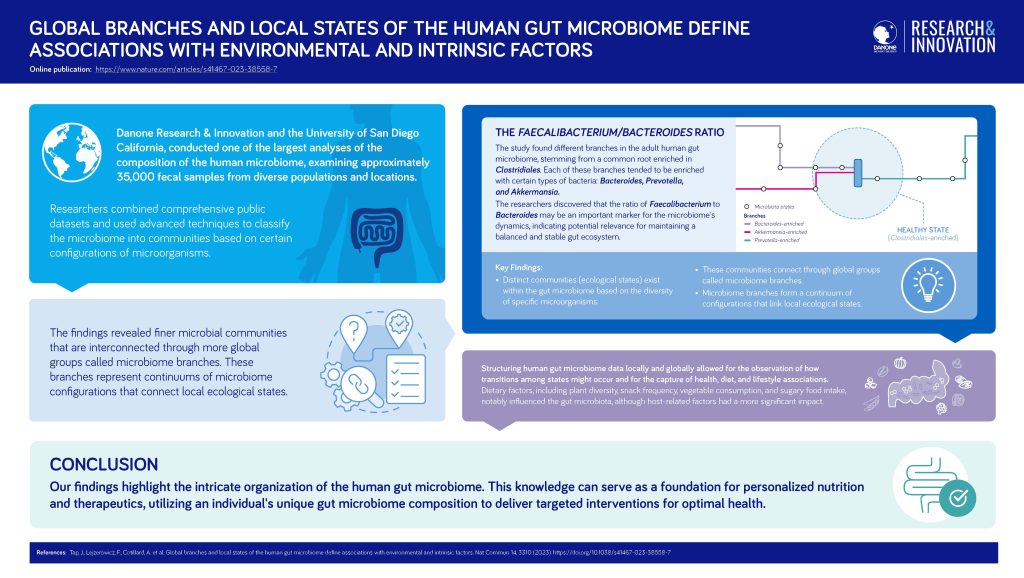Title: Global branches and local states of the human gut microbiome define associations with environmental and intrinsic factors
| Authors: | Julien Tap et al. |
| Published: | 2023 |
| Journal: | Nature Communications |
 In the recent study “Global branches and local states of the human gut microbiome define associations with environmental and intrinsic factors” published in Nature Communications, researchers from Danone Research & Innovation and the University of San Diego California examined approximately 35,000 fecal samples from diverse populations and locations, making it one of the most extensive investigations in this field.
In the recent study “Global branches and local states of the human gut microbiome define associations with environmental and intrinsic factors” published in Nature Communications, researchers from Danone Research & Innovation and the University of San Diego California examined approximately 35,000 fecal samples from diverse populations and locations, making it one of the most extensive investigations in this field.
The findings uncovered different communities within the gut microbiome based on certain configurations of microorganisms, which they described as ecological states. These configurations are interconnected within broader global groups referred to as microbiome branches, which represent a continuum of microbiome configurations connecting local ecological states.
The researchers analyzed comprehensive public datasets containing diverse populations and age groups. They specifically examined data from curatedMetagenomicData (CMD), consisting of over 18,000 fecal metagenome samples, and the American Gut Project (AGP), which included more than 17,000 microbiome samples. By utilizing clustering techniques, such as Dirichlet Multinomial Mixture models, and ordination approaches, the researchers classified the microbiome into finer ecological states (communities) linked within global microbiome branches (groups).
The study identified distinct branches within the human gut microbiome enriched with certain bacteria: Bacteroides, Prevotella, and Akkermansia. Remarkably, the presence of Bacteroides and Prevotella branches was consistent across both the CMD and AGP datasets, demonstrating the reproducibility of the microbiome configurations across different datasets.
The researchers observed significant shifts between different microbiome states in individuals within the Bacteroides-enriched branch. They found that variations in the Faecalibacterium-to-Bacteroides ratio served as a good indicator of microbiome instability. These findings suggest that changes in this ratio may reflect the overall dynamics and balance of the microbiome.
Furthermore, the analysis unveiled the considerable impact of certain host-related factors on the gut microbiota. Age, body mass index (BMI), frequency of bowel movements, antibiotics use, and birth region emerged as the most influential predictors. While dietary factors had a relatively smaller impact, they still shaped the gut microbiome. Among these factors, plant diversity, frequency of snacks, consumption of vegetables, and intake of sugary foods exhibited a relatively higher influence on gut microbiota.
The results provide valuable insights into the intricate organization of the human gut microbiome and emphasize the importance of structuring human gut microbiome data at both local and global levels. Such an approach enables a better understanding of not only how transitions might occur among states, but also the associations between the microbiome and health, diet, and lifestyle.
They can also establish a foundation for future personalized nutrition and therapeutics by leveraging an individual’s unique gut microbiome composition to ensure proper nutritional intervention to optimize health.
Read the full publication here: Global branches and local states of the human gut microbiome define associations with environmental and intrinsic factors | Nature Communications
Read more about our research into Gut Health here: Gut Health | Danone Research & Innovation